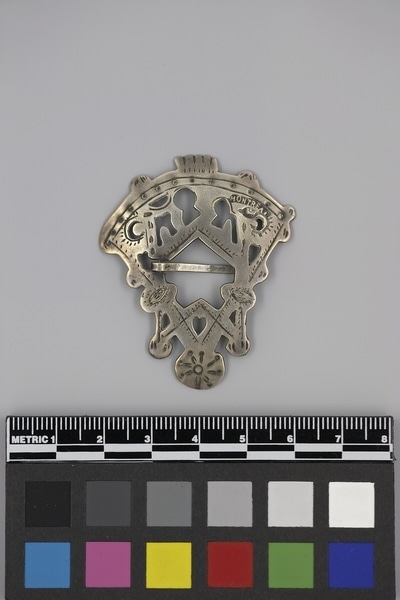Brooch Item Number: 1590/108 from the MOA: University of British Columbia

Description
Masonic-style brooch with circular disc at top engraved with radial design of eight lines and dots. Geometric opening at centre of brooch and inverted heart above. Lower portion of brooch decorated with 1 heart-shaped cutout, 2 crescents, 1 half-moon and 3 irregular decorative shapes. Bottom decorated with incised lines and a row of 13 dots. Cross-pin attached. Stamped with maker’s mark.
History Of Use
Silver ornaments represent an important part of early exchange between Europeans, including fur traders, and First Nations people, especially in eastern and central Canada and the USA. Initially, the main source of silver was British, French and Spanish coins. Most ornaments were produced by silversmiths of European origin in North America and Europe, and were actively traded only from 1760 to 1821. By the mid-18th century silver objects were produced in New England, Quebec and Montreal. Silver was used by First Nations people as a sign of rank. Silver ornaments in these styles continue to be produced by native silversmiths in central Canada and the USA. Brooches were the most popular and numerous silver ornaments. They were worn on the chest, but also in the hair. Frequently, many were worn at once in rows across the chest.
Specific Techniques
Repousse is a type of ornamentation formed in relief in metal by hammering up from the reverse or inner side.
Cultural Context
trade; personal decoration; status
Iconographic Meaning
Secret Masonic emblem of compass and square adopted by Iroquois to represent the “Council fire”, a meeting of chiefs. The Freemasons' symbols are plumb, compass, square, level. The Masonic-type brooch may have been introduced by Mohawk Iroquois Chief, Joseph Brant, who in 1775 became a member of the Masonic Order in London.
Item History
- Made in Montreal, Quebec, Canada ? between 1760 and 1821
- Owned by Kathleen E. Reif before September 9, 1993
- Received from Kathleen E. Reif (Donor) on September 9, 1993
What
Who
- Culture
- Eastern Woodlands
- Previous Owner
- Kathleen E. Reif
- Received from
- Kathleen E. Reif (Donor)
Where
- Holding Institution
- MOA: University of British Columbia
- Made in
- Montreal, Quebec, Canada ?
When
- Creation Date
- between 1760 and 1821
- Ownership Date
- before September 9, 1993
- Acquisition Date
- on September 9, 1993
Other
- Item Classes
- metalwork
- Condition
- good
- Current Location
- Case 45
- Accession Number
- 1590/0108